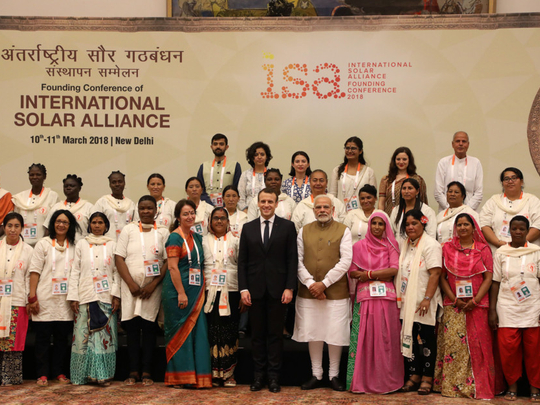
In Delhi, on Sunday, Indian Prime Minister Narendra Modi and French President Emmanuel Macron co-chaired the first International Solar Alliance (ISA), a group of 62 nations determined to make solar energy the main source of light and heat in practical applications.
Who would quarrel with the good intention of the 33 nations present at the convention? Who would grudge them that almost altruistic ambition?
Yet, amid all the bonhomie and earnest aspiration, there was a shadow. The shadow of superstition.
Indeed, with Macron promising some $860 million (Dh3.16 billion) by 2022 for solar projects in developing countries, and Modi himself claiming his country would be generating 175 gigawatts — gigawatts, as a cynic improved upon the term — power from renewable sources by the now nearly magical goal year of 2022, in fact, double India’s renewable energy capacity, there was the ubiquitous Vedic reference uttered by Modi, and stranger than usual for the context.
As a newspaper quoted him, this is what Modi said: “Vedas consider the Sun as the soul of the world, it has been considered as a life nurturer. Today, for combating climate change, we need to look at this ancient idea to find a way,” Modi said in New Delhi.
This is in keeping with a recent trend on the part of the Modi regime to find ancient answers to modern questions.
It is not uncommon these days to find researchers in accredited institutions actively writing academic papers reinterpreting what is now popularly called “Vedic science.” Consider for example a paper titled, Origin of Environmental Science From Vedas by Shashi Tiwari, where he says: “In Vedic view, this world consists of Agni i.e., fire or heat and Soma or water. Sun [Surya] is the soul of all which is moving and also of which is not moving.”
While it is not clear what is the exact text or dissertation upon which Modi based his observations, the general thought process of the Vedic scientists consist, in this context, of seeing the sun as the source of our existence.
The central relationship of sun to Man is fairly plain, and is likely to be evident even to our ancestors. And as in the quote above, what we get in Hindu scriptures is praise for the sun. But that hardly warrants attributing to them a whole metrics of the sun, a whole science of deriving energy from the sun.
This is not the first time, the ruling BJP has resorted to the scriptures for a Hindu hegemony of sorts over the discipline of science. Since their coming to power in 2014, important leaders like the union home minister Rajnath Singh has repeatedly exhorted the layman and the specialist to go back to the Vedas and Mahabharata for answers.
There have been allusions from the spokesmen of the BJP and its mother organisation, RSS (Rashtriya Swayamsevak Sangh), that IVF, for instance, had been widely practised in those distant times. Teleportation, too, a wildly popular mode of transport of the saints. Not to mention planes (as in Ravan’s use of Pushpak Viman to abduct Sita in Ramayana) or the use of nuclear missiles (as in the bow and arrow battles between Arjun and Ashwathama in Mahabharata).
To find a clear science of physics or biology in these stories of great power is a strange, infantile obsession. To actually fund institutions and individuals in this pursuit is a waste of meagre resources. But for a prime minister to believe and advocate a myth written or told over 3,000 years ago at an international convention of alternate energy is to officially endorse a Vedic prayer to the sun as a whole science of life is a general licence for a society to slip into mayhem.
The prime minster unexceptionally concluded his address at the ISA by quoting the Shanti Mantra from the Brihadaranyaka Upanishad, Tamaso ma jyotir gamaya, which translates as “Lead me from darkness to light”. This is an aspirational sentiment.
The trouble is to believe that the light is ever at your back, in the past. Look back, if you must; but march forward. Certainly, for India, there is a lot of ground to cover.
C.P. Surendran is a senior journalist based in India.










